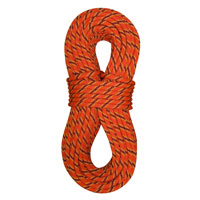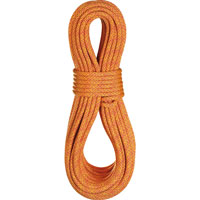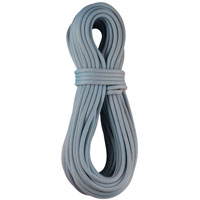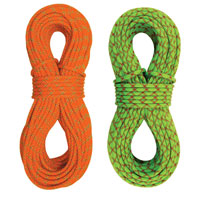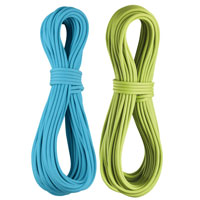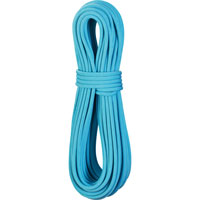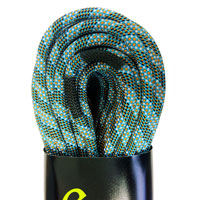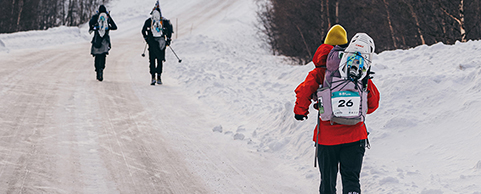Rock Climbing Ropes: How to Choose
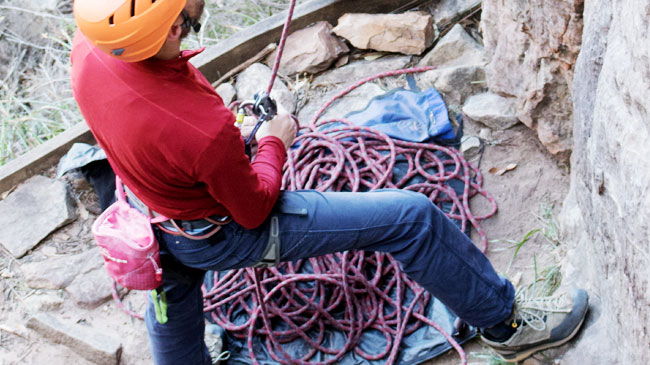
James Scott-Bohanna belays at The Watchtower in the Grampians. Photo: Chelsea Brunckhorst
Rock climbing ropes come in different diameters and lengths. Some are dry treated; others are not. Some must be used in a pair; others are designed to be used singly. All the ropes discussed here are dynamic ropes, which are the type essential for lead climbing.
When buying a rope, certain types will suit your needs, and others may not. So, how do you know which rope to choose? That depends on what, primarily, you'd like to use it for.
If you're logging lots of hours in a climbing gym, you'll need something different from someone climbing mountains in New Zealand.
Here are our recommendations for a few common scenarios.
Best Rope for Top-roping
We recommend: Sterling Marathon Pro 10.4 x 60m
What you're looking for in a top-rope is something durable. "A big, fat, beefy rope that's unkillable," as Bogong's assistant manager James puts it.
That's because top-ropes are often used intensively. They're also more likely to be loaded while running over edges, and rubbing against rock.
The Sterling Marathon Pro fits this bill because it's a strong, hardwearing rope. There are a number of reasons why this is so.
Firstly, the fibres in the Marathon Pro's sheath are woven tightly. This makes a stronger rope than one that is more loosely woven.
Secondly, the Marathon Pro has a high percentage of sheath to core, giving added protection to the core (which is the inner part of the rope and provides the rope's tensile strength).
Thirdly, the Marathon Pro is double braided. This means that when you inspect the pattern on the rope, you might be able to see that there are two strands lying on top of another two strands. This is better for the sheath's durability. The way the strands are interlocked, if one strand is pulled out of place, the others tighten up.
Finally, like all Sterling ropes, the Marathon Pro has a dry core. This means that the rope's core is treated to keep water out. (Water dramatically weakens ropes.)
These elements combine to result in a rope that can withstand the rigours of top-roping.
If you're trying to decide between the 10.4mm version and the 10.1mm: the 10.4mm option offers better durability. But, if you're after a rope you'll be leading on too, opt for the 10.1mm.
Also consider: Sterling Marathon Sport 10.1 x 60m
Best Rope for Gym Climbing
We recommend: Edelrid Hawk 10mm x 60m
There are several things you don't need in a gym rope. And, if the gym is where you do most of your climbing, there's no sense in paying extra for elements that you don't need in a rope.
Weight, for instance, is not an issue in the gym. (You're not carrying the rope on an epic walk-in, and you're also not carrying a full rack up the wall.)
Climbing gyms in Australia aren't particularly tall, so you don't need a super long rope (a 50- or 60-metre rope will do). You also don't need the rope to handle particularly well, since you're not going to be tying an assortment of strange knots.
With that in mind, the Edelrid Hawk 10mm is an affordable all-rounder.
Also consider: Edelrid Tjuringa 10mm x 50m
Best Single Rope for Multipitch Trad Climbing
We recommend: Edelrid Boa 9.8mm x 70m
A good trad rope strikes a balance between durability, handling and weight. A skinnier rope is more supple, and therefore handles better than a fat rope. However, ropes used for trad climbing often run over edges, so the rope needs to be durable.
That's why we recommend 9.8mm ropes like the Sterling Velocity and the Edelrid Boa.
The latter, like all Edelrid ropes, has a special kind of heat treatment that gives the rope the suppleness that Edelrid is famous for.
Alternatively, you could also use two half ropes (e.g. Edelrid Sinai). Using double ropes lets you minimise rope drag and do longer abseils.
Also consider: Sterling Velocity 9.8mm x 70m; Edelrid Sinai 8.3mm x 60m (x2)
Best Double Ropes for Multipitch Trad Climbing
We recommend: Sterling Duetto Dry 8.4mm x 60m (sold singly)
A skinny lightweight rope with good durability. It's also double dry (dry core and dry-treated sheath), which means that in wet weather your rope is more protected. This makes it a good rope for alpine climbing too.
The reason you would choose this over something like the Edelrid Apus Pro Dry Pair 7.9mm is that you don't want to be falling regularly on trad gear on such a thin rope. That diameter is fine for alpine climbing, where you make a trade-off for weight. But for trad climbing, 8.4mm is more balanced.
Often, for wandering trad routes, two ropes is preferable. You don't have to extend gear as much, and there's way less rope drag. Double ropes also facilitate longer abseils without you having to carry an extra rope on your back or your haul loop.
Best Rope for Mountains
We recommend: Edelrid Apus Pro Dry Pair 7.9mm x 60m
Ropes for the mountains need to be as skinny as possible, to save weight.
We always recommend double ropes, which give you more rope for longer abseils.
For mountaineering, you also need a rope that won't freeze. A frozen rope not only can't be used effectively, it also takes on weight. That's why we suggest the Edelrid Apus Pro Dry – it's sold as a pair. It's super skinny, and also dry treated.
Specialist Ropes
We recommend: Edelrid Eagle Light Pro Dry 9.5mm x 60m
Need a 'send' rope?
Consider ropes that are 9.5mm and below, where handling, ease of clipping and low weight are more important than wear and tear.
They're ideal ropes for sending your latest project. But, bear in mind, they're not ideal for top-roping.
Also consider: Edelrid Swift Pro Dry 8.9mm x 60m, Sterling Ion Dry 9.4mm x 60m
Best Value Climbing Rope
We recommend: Edelrid Tjuringa 10mm x 60m
If you're just starting out, or you're on a tight budget, you can still buy a good rope.
The Edelrid Tjuringa and Edelrid Parrot are both high quality ropes, made to the same standards as all of Edelrid's other ropes. (By the way, Edelrid invented the kernmantle rope used in modern climbing.)
Both these ropes are excellent ropes, but won't totally break the bank.
Also consider: Edelrid Parrot 9.8mm x 70m
How long does my climbing rope need to be?
It depends on what you're using the rope for.
For outdoor purposes, we recommend a 60-metre rope, minimum. In Europe, you'll need 70-metre rope at least (because standard anchor points are at 35 metres). A 70-metre rope is also useful for long, wandering pitches. And, you'll have the option to do more single-rope abseils.
A 50-metre rope is sensible if you do all your climbing in the gym. (Or, you're after a second rope for using purely in the gym.) That's because most gyms in Australia aren't very tall. Likewise, if you live in an area where the cliffs tend to be quite short, perhaps a 50-metre rope is all you need.
See our full range of climbing ropes here.
Questions? Visit us, email us or call us (03 9600 0599).
More Articles







